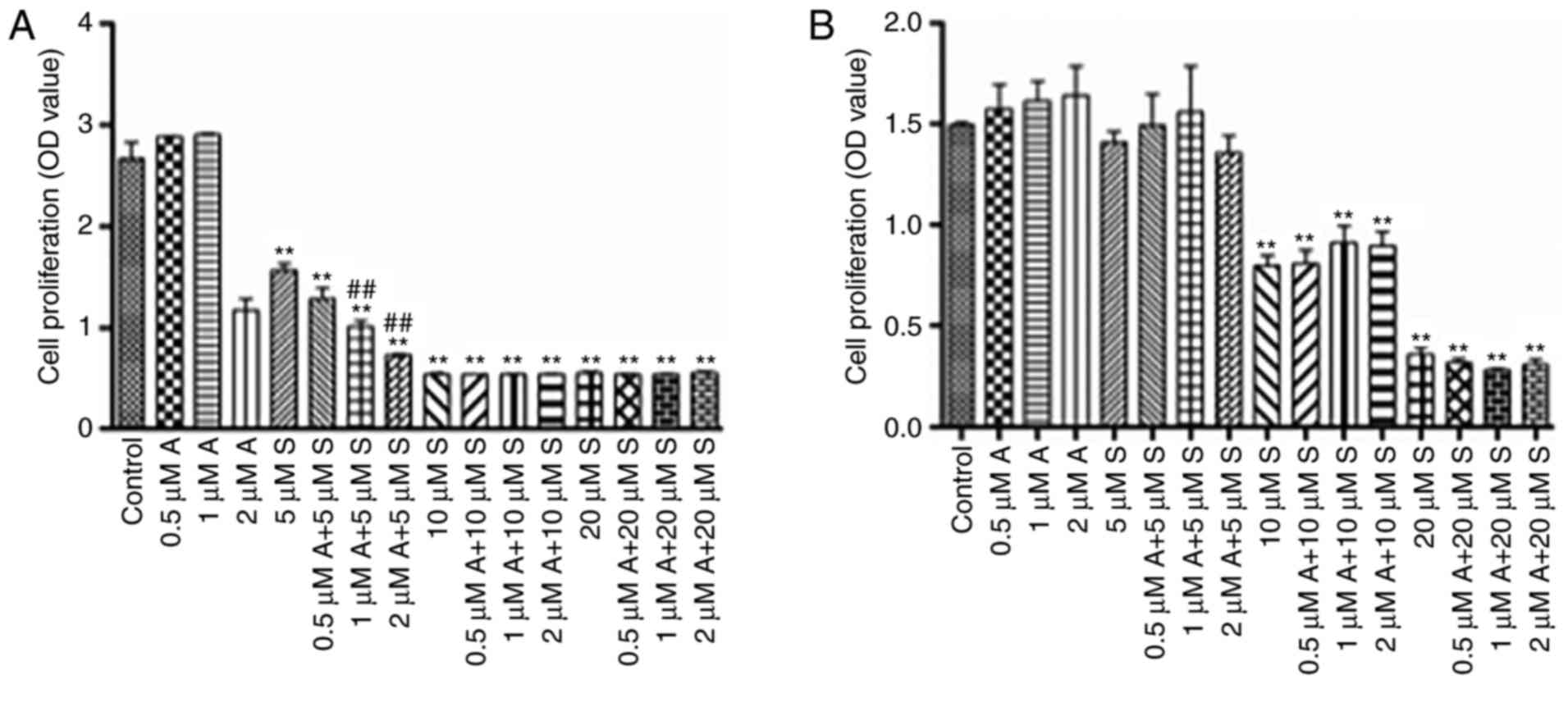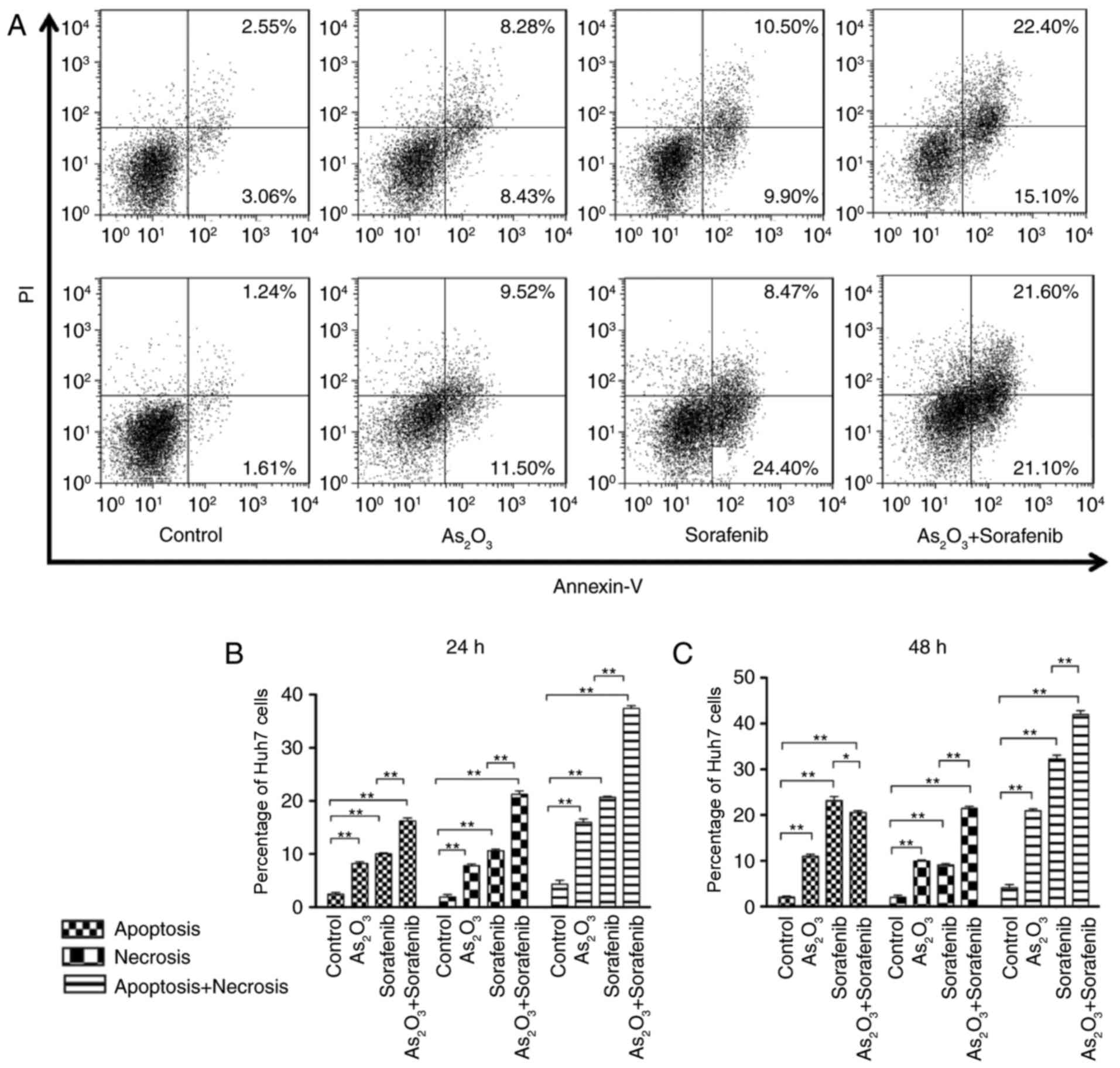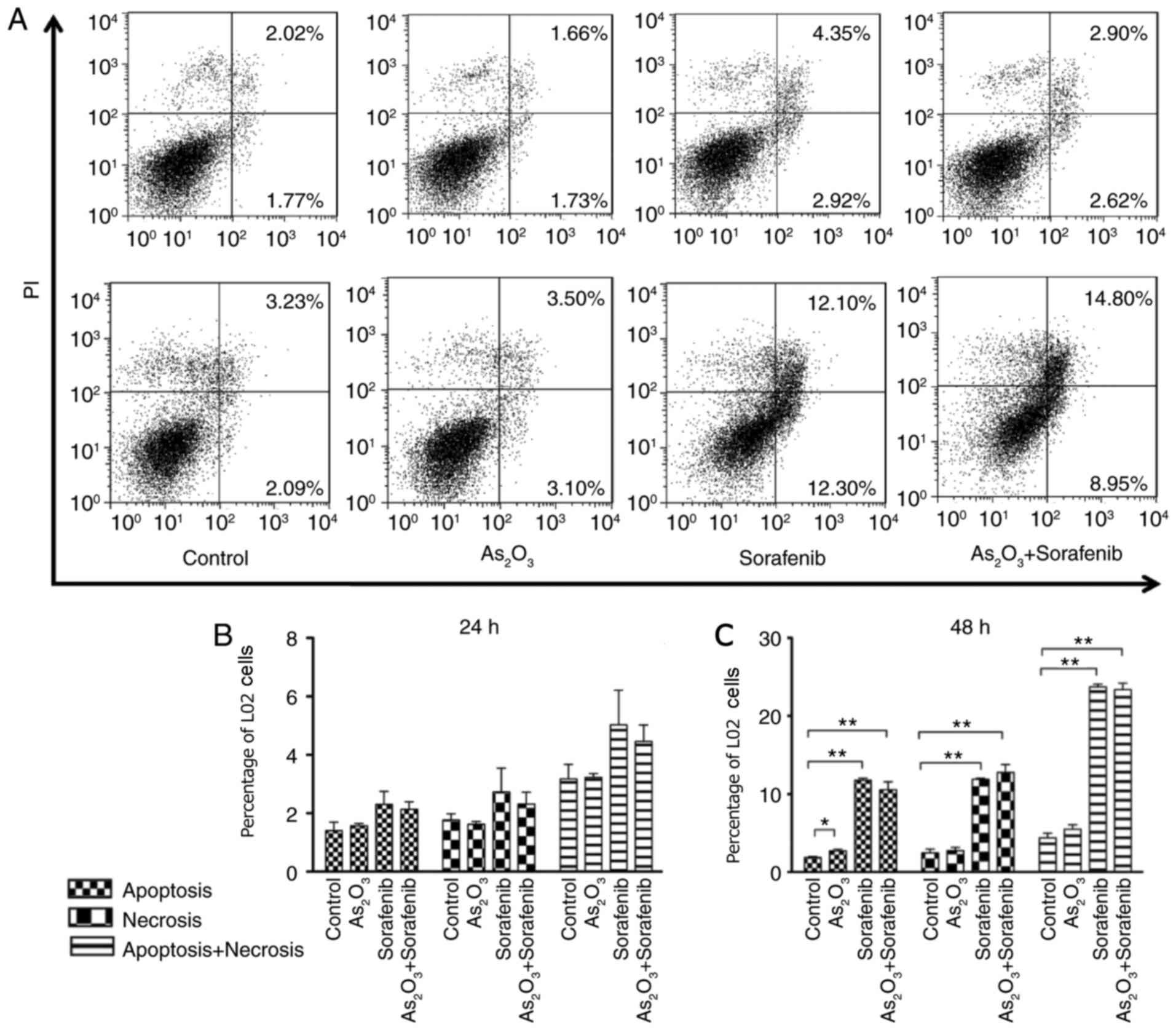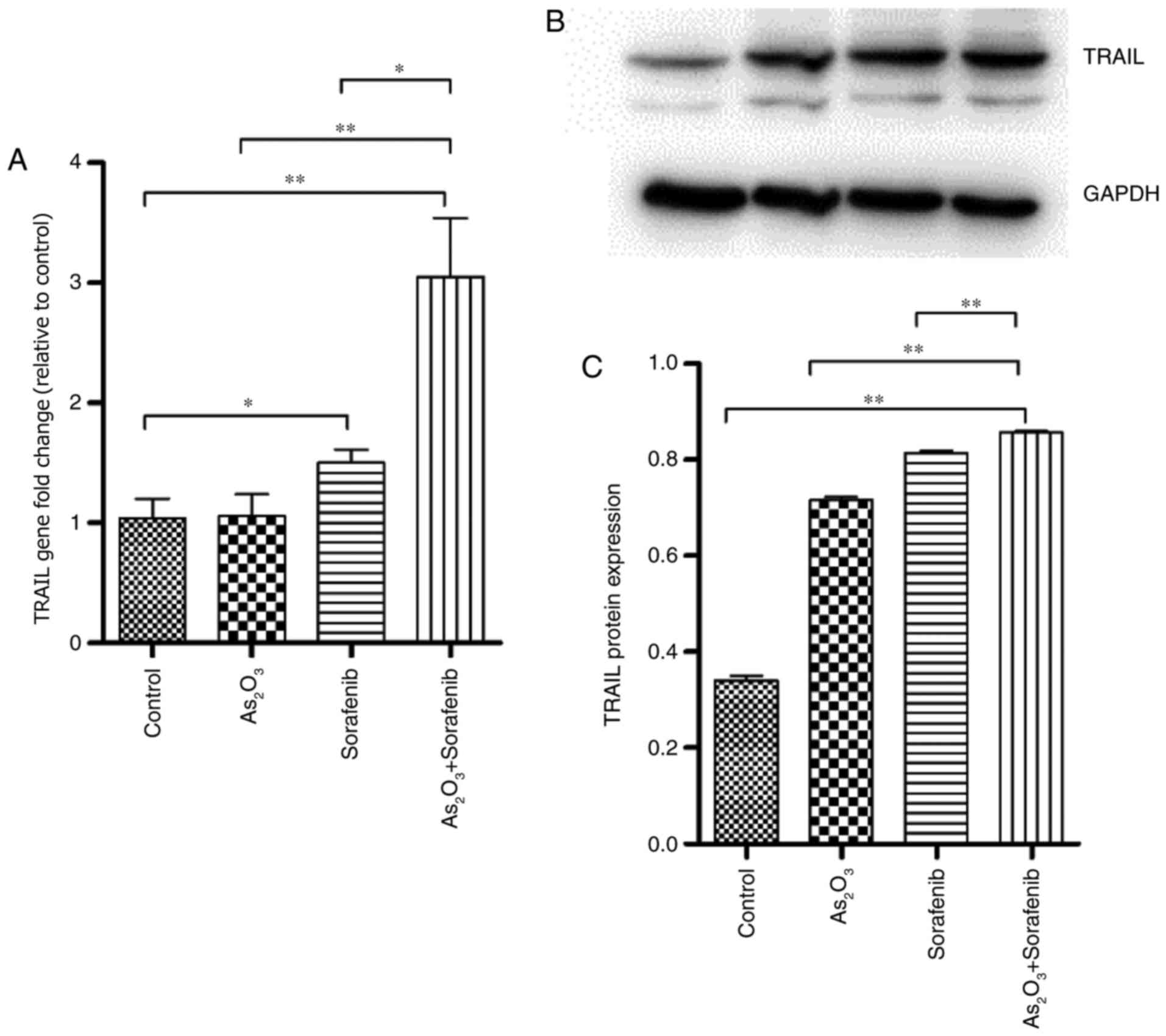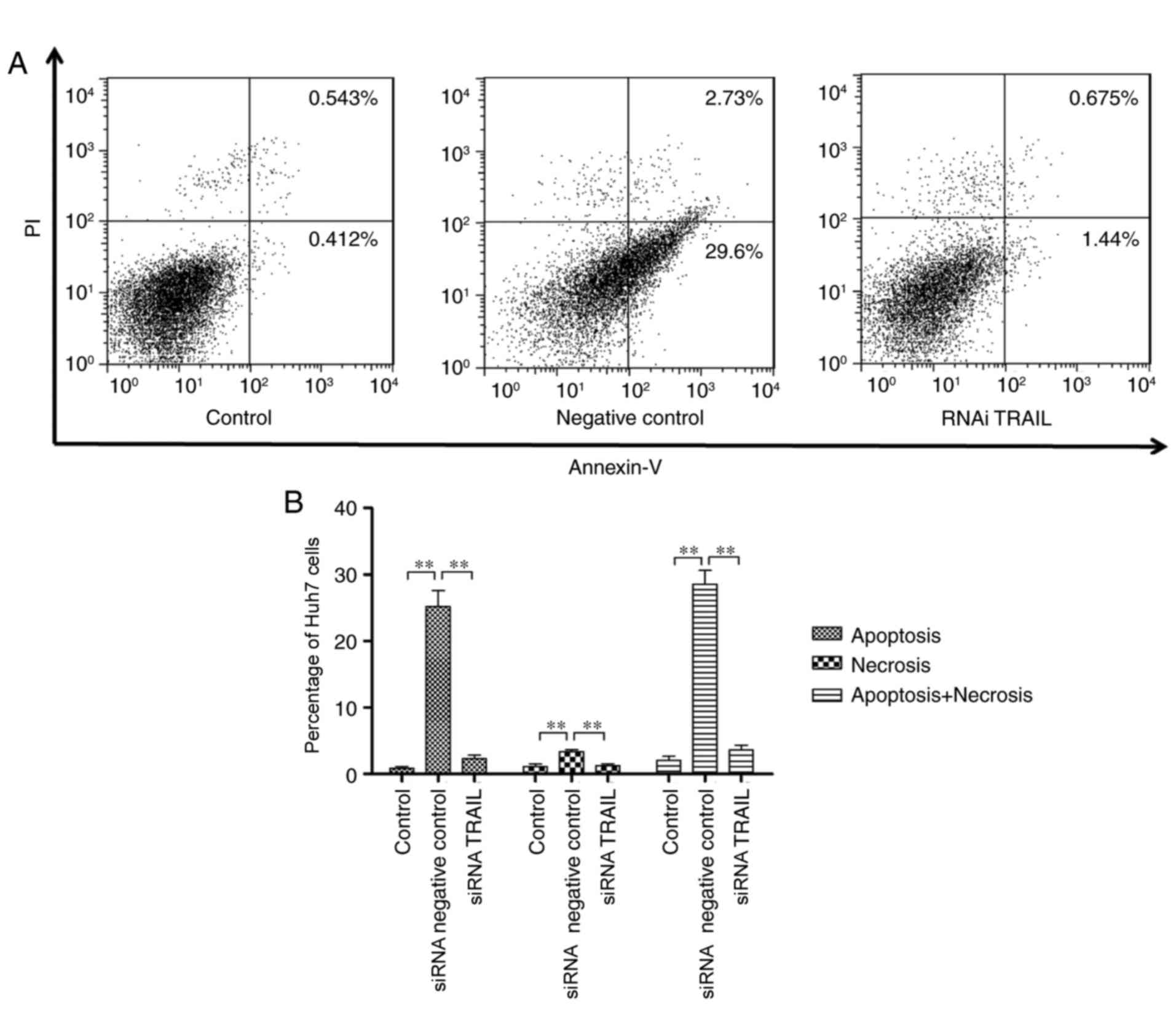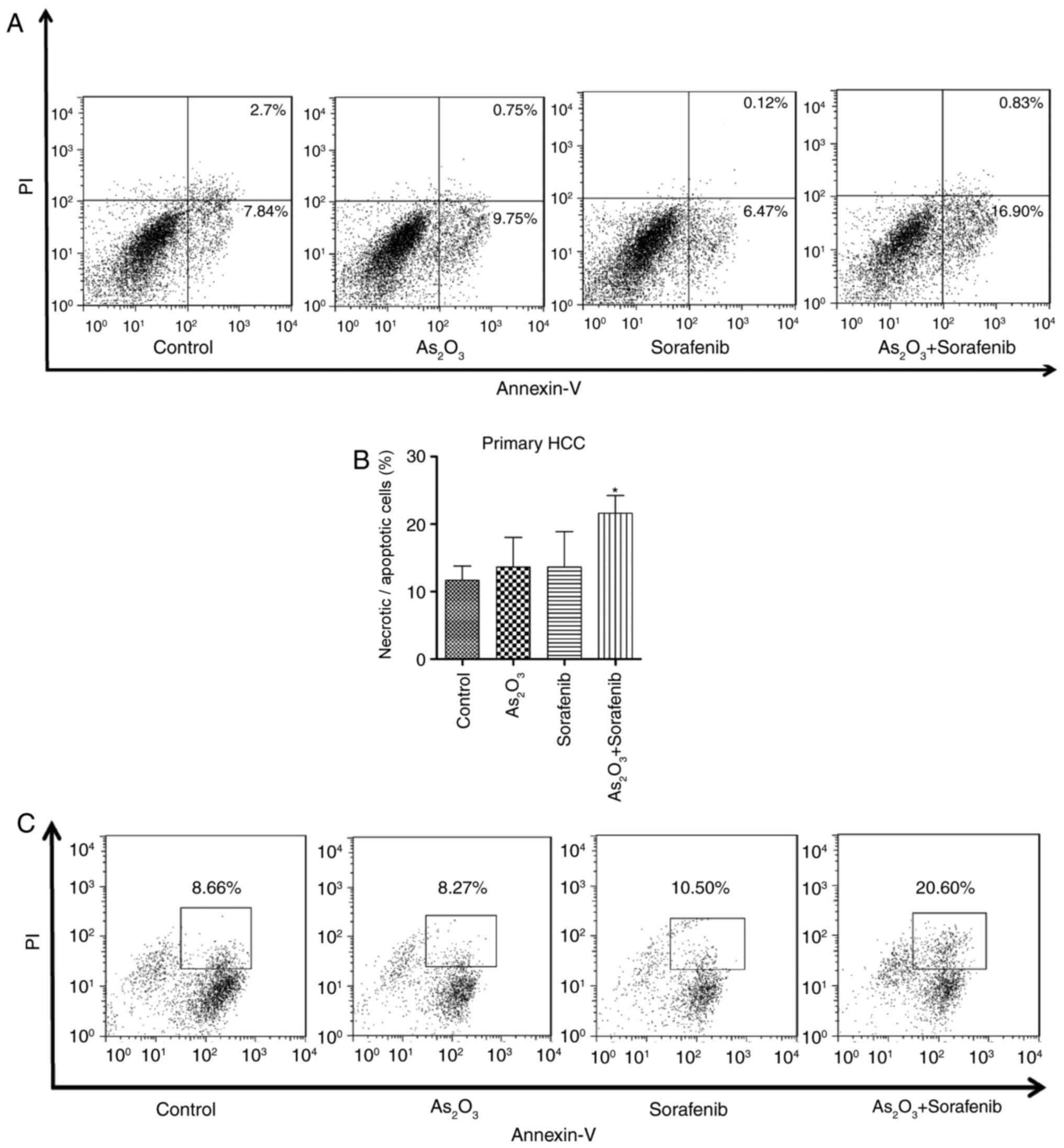Arsenic trioxide and sorafenib combination therapy for human hepatocellular carcinoma functions via up‑regulation of TNF‑related apoptosis‑inducing ligand
- Authors:
- Published online on: June 18, 2018 https://doi.org/10.3892/ol.2018.8981
- Pages: 3341-3350
Abstract
Introduction
As the second leading cause of cancer-associated mortality in men, and the sixth in women worldwide (1), human hepatocellular carcinoma (HCC) remains a severe global health threat. Chronic infections of hepatitis B virus (HBV) and hepatitis C virus (HCV) are major risk factors associated with HCC (2). With an increased rate of HBV/HCV infection and other risk factors, including obesity, cigarette smoking, diabetes mellitus and heavy alcohol consumption, the incidence of HCC has also increased (3). In order to prevent HCC progression, tumor resection, liver transplantation and radiofrequency (thermal) ablation [RF(T)A] are commonly used for HCC treatment (4–6). Although these treatments have improved the survival rates of patients with HCC, they are only appropriate for a minority of patients, and their efficacies are limited by high recurrence rates (7). Hence, new systemic therapies for HCC are urgently required.
Sorafenib, an oral multi-kinase inhibitor, can block certain signaling pathways, including those of Raf kinase and vascular endothelial growth factor (VEGF) (8). Multiple phase III clinical studies have indicated its effect of improving the survival of patients with HCC and delaying radiological progression (9). Therefore, it has been proposed as the standard treatment for patients with advanced HCC. Considering its strong effect on the suppression of angiogenesis and the induction of apoptosis (10), it has also been approved for the treatment of other types of advanced cancer, including renal cell carcinoma (11), breast cancer (12) and leukemia (13). However, the survival benefits for patients with HCC treated with sorafenib treatment are modest due to individual variation and toxicity (14). The establishment of sorafenib-based therapeutic combination options is required to improve the overall survival rate of patients with HCC.
Arsenic trioxide (As2O3), a traditional Chinese medicine, has been widely used to treat acute promyelocytic leukemia (APL) (15). It induces differentiation at low concentrations (<0.5 µM) and increases apoptosis at higher concentrations (0.5–2.0 µM) in APL cells (16). Previous studies have used As2O3 to treat various types of solid cancer, including small cell lung cancer (17) and colon cancer (18). Despite its ability to inhibit hepatocellular tumor growth and cell apoptosis in vitro (19), a phase II clinical trial reported that As2O3 had limited activity against advanced HCC (20). On the other hand, a different study demonstrated that As2O3 potentiated the anticancer activity of sorafenib in HCC by inhibiting Akt activation (21). As2O3 in combination with chemotherapy is now considered to have potential in cancer therapeutics (22). However, the effect of sorafenib/As2O3 combination on primary HCC cells and the underlying mechanisms remain to be elucidated.
TNF-related apoptosis-inducing ligand (TRAIL), also known as Apo2L, is a member of the TNF superfamily with potential for anticancer therapy (23). TRAIL induces apoptosis through interacting with its receptors, death receptor (DR)4 and 5, causing tumor-cell death (24). The upregulation of TRAIL expression is directly involved in the inhibition of tumor initiation and metastasis (25,26). However, regulation of the TRAIL ligand remains poorly understood compared with TRAIL receptor-binding.
To provide a novel solution to sorafenib-resistance in HCC, the present study aimed to evaluate the efficacy of As2O3/sorafenib combined treatment against primary HCC cells and its impact on TRAIL expression. We hypothesized that the synergistic interaction of As2O3 and sorafenib would induce apoptosis of HCC cells via a TRAIL-dependent pathway. Furthermore, this synergistic effect was analyzed in fresh-isolated HCC cells.
Materials and methods
Isolation of fresh HCC cells
A total of 10 patients with HCC, including 4 females and 6 males, aged between 48 and 79 years, with a median age of 62 years, who were either HBV- or HCV-positive underwent surgical resection at Zhongshan Hospital (Shanghai, China) between January 2013 and December 2014. HCC tissues were collected at surgery, washed in Hank's solution (8.0 g NaCl, 0.2 g KCl, 0.2 g Na2HPO4·H2O 1.56 g, KH2PO4 in 1 l distilled water) and sliced into 0.5–1.0-mm3 sections. Sections were incubated with 5–10 ml collagenase containing penicillin (100 U/ml)/streptomycin (100 mg/ml) at 37°C for 30 min, and centrifuged at 4°C, 300 × g for 12 min to achieve a single-cell suspension. HCC cells were isolated by repeated trypsinization and adhesion. The present study was approved by the institutional review board of Zhongshan Hospital, Fudan University (Shanghai, China). Written informed consent was obtained from all patients in accordance with the Declaration of Helsinki.
Cell culture
The human HCC cell lines, Huh7, 97H and L-02, were purchased from the Cell Bank of the Shanghai Institutes for Biological Science (Shanghai, China). Huh7, 97H, L-02 and freshly-isolated HCC cells were cultured in Dulbecco's modified Eagle's medium (DMEM) supplemented with 10% fetal bovine serum (FBS; Biowest, Nuaillé, France) and penicillin (100 U/ml)/streptomycin (100 mg/ml). Cell cultures were maintained at 37°C in a humidified atmosphere with 5% CO2. HCC cells were seeded in 6-, 24- or 96-well plates and incubated overnight for attachment. Following 24-h starvation, cells were treated with different concentrations of sorafenib (5, 10 and 20 µM) and As2O3 (0.5, 1 and 2 µM) for 24, 48 and 72 h. A medium-only group served as a negative control.
Cell Counting Kit-8 (CCK8) assay
The culture medium was discarded and 100 µl serum-free DMEM was added to each well with 10 µl CCK8 assay reagent (Dojindo Molecular Technologies, Inc., Kumamoto, Japan). After a 4-h incubation at 37°C, the absorbance was measured at 450 nM using a microplate reader (Molecular Devices, LLC, Sunnyvale, CA, USA). A total of 6 replicates were performed for each sample to obtain a mean value. The drug combination index value was calculated according to Jin's formula: Q=E(A+B)/(EA+EB-EA*EB) (27). E(A+B) being the inhibitory effect of the co-treatment of 2 drugs, while EA and EB are the inhibitory effects of the single drugs.
Apoptosis assay
Apoptosis was measured using an Annexin-V-FITC Apoptosis Detection kit (BD Bioscience, Franklin Lakes, NJ, USA), according to the manufacturer's protocol. Briefly, following single- or combined-agent drug treatments, 1×105 cells were washed twice with cold PBS and resuspended in 500 µl binding buffer for Annexin-V and propidium iodide (PI) staining. After staining, ~20,000 cells were analyzed using a FACS Arial II system (BD Biosciences). Annexin-V+PI- cells were analyzed as apoptotic and Annexin-V+PI+ cells were regarded as necrotic cells.
RNA isolation and reverse transcription-quantitative polymerase chain reaction (RT-qPCR)
Total RNA of HCC cells following single or combined treatment was isolated using TRIzol (Thermo Fisher Scientific, Inc., Waltham, MA, USA), according to the manufacturer's protocol. 1 mg total RNA from each sample was reverse-transcribed to cDNA using a PrimeScript® RT reagent kit (Takara Bio, Inc., Otsu, Japan), according to the manufacturer's protocol. RT-qPCR was performed using SYBR® Premix Ex Taq™ (Takara Bio, Inc.), according to the manufacturer's protocol, and cDNA amplification was detected using a 7500 RT-PCR system (Applied Biosystems; Thermo Fisher Scientific, Inc.) for 40 cycles at 95°C 5 sec and 60°C 30 sec. Relative gene expression was quantified using the 2−ΔΔCq method (28). The sequences of each primer used are listed in Table I (Invitrogen; Thermo Fisher Scientific, Inc.).
Western blot analysis
Western blotting was performed as previously described (7). Briefly, HCC cells were harvested following single or combined drug treatment by scraping. The cells were incubated with lysis buffer (1 mmol/l EGTA, 150 mmol/l NaCl, 1% Triton X-100, 2.5 mmol/l sodium pyrophosphate, 1 mmol/l PMSF, 1 mmol/l Na3VO4, 1 mg/ml leupeptin, 1 mg/ml aprotinin, 5 mmol/l NaF in 20 mmol/l Tris-HCl buffer, pH 7.5). Cell lysates were centrifuged at 13,000 × g, 4°C for 30 min. Protein concentration was determined using the BCA protein analysis (Thermo Fisher Scientific, Inc.) and 40 µg of protein from each sample of protein were separated by 10% SDS-PAGE gels. The separated proteins were transferred onto PVDF membranes. After blocking with 5% nonfat dry milk in double-distilled water at room temperature for 1 h, membranes were washed 3 times with TBS containing 0.1% Tween (TBS-T) at room temperature for 5 min each time and incubated overnight at 4°C with anti-TRAIL (cat. no. 3219S; Cell Signaling Technology, Danvers, MA, USA) and anti-GAPDH (cat. no. 5174S; Cell Signaling Technology) at a 1:1,000 dilutions overnight. The membranes were washed 3 times with TBS-T at room temperature for 5 min each time, followed by 1 h incubation at room temperature in a 1:1,000 dilution of horseradish peroxidase conjugated goat anti-rabbit secondary antibody (cat. no. 111-035-003; Jackson Laboratory for Genomic Medicine, Farmington, CT, USA). Following incubation, membranes were washed 3 times with TBS-T and were visualized by enhanced chemiluminescence (Pierce ECL Western Blotting Substrate; Thermo Fisher Scientific, Inc.).
RNA silencing
TRAIL was downregulated in HCC cells using siRNA duplexes (GenePharma, Co., Ltd., Shanghai, China). Briefly, untreated Huh7 cells were seeded in a 6-well plate at 5×105 cells per well, and incubated overnight for attachment. After growing to 80–90% confluency, the cells were transfected with 20 nM TRAIL siRNA or negative control (the sequences of all siRNA are listed in Table II) using Lipofectamine 2000 (Thermo Fisher Scientific, Inc.), according to the manufacturer's protocol, in Opti-MEM medium (Gibco; Thermo Fisher Scientific, Inc.) without FBS. A total of 6 h later, the media was replaced by DMEM containing 10% FBS. A total of 24 h later, mRNA was used to detect the efficiency of transfection by RT-qPCR. After 48 h, HCC cells were treated with 1 µM As2O3 and 5 µM sorafenib for further research.
Statistical analysis
All analyses were performed using SPSS software (version 13.0; SPSS Inc., Chicago, IL, USA). Data are expressed as the mean ± standard error of the mean. Normality was assessed by Shapiro-Wilk test. One-way analysis of variance or Kruskal Wallis testing was used for normal or non-normal data, respectively. The least significant difference test was used for post-hoc multiple comparisons. P<0.05 was considered to indicate a statistically significant difference.
Results
Effects of As2O3 and sorafenib, alone and combined, on the proliferation of Huh7 and 97H cells
To investigate the effect of As2O3 with and without sorafenib on liver cancer cell lines, Huh7 and 97H, cells were stimulated with drugs at different concentrations for 72 h. Huh7 proliferation was significantly inhibited at high doses of As2O3 (2 µM, 1.174±0.113 vs. 2.882±0.007, in As2O3-treated and control cells, respectively; P<0.01; Fig. 1). Proliferation was suppressed at all concentrations of sorafenib alone, even at the lowest dose of 5 µM (1.564±0.070 vs. 2.882±0.007 in sorafenib-treated and control cells, respectively; P<0.01, Fig. 1). Huh7-cell proliferation was inhibited in an As2O3-concnetration-dependent manner when treated with sorafenib in the presence of varying concentrations of As2O3 (Fig. 1). To determine whether the combined treatment had a synergistic impact on cell proliferation, the combination index values of each dose were calculated according to Jin's formula. At a concentration of 5 µM sorafenib and 1 µM As2O3, a synergistic effect was evident (Q=1.7>1.4). The effect on proliferation at high doses (20 µM) of sorafenib and As2O3 resulted in cell death (Fig. 1). However, a synergistic effect was not detected in 97H cells. Inhibition of proliferation of 97H cells was evident only at high concentrations of sorafenib (0.795±0.052 vs. 1.495±0.015, in 10 µM sorafenib-treated and control cells, respectively; P<0.01; 0.359±0.034 vs. 1.495±0.01520 in 20 µM sorafenib-treated and control cells, respectively; P<0.01; Fig. 1).
Combined treatment of As2O3 and sorafenib increases cell death in Huh7 cells via TRAIL
When treated with 1 µM As2O3, or 5 µM sorafenib, or a combination of the two drugs, for 24, 48 and 72 h, the apoptotic rate was significantly increased in Huh7 cells. Combination treatment demonstrated a synergistic effect on apoptosis and necrosis (P<0.01; Fig. 2). After 72 h with combination treatment, almost all Huh7 cells were Annexin-V+ (data not shown). Sorafenib resulted in significantly increased cell death after 48 h in normal liver (L-02) cells, but not after 24 h (Fig. 3). A number of genes associated with apoptosis were examined by RT-qPCR (data not shown), which demonstrated that the gene expression of TRAIL selectively induced apoptosis in tumor cells (29). TRAIL expression was significantly upregulated in the combination treatment group compared with the control and single treatment groups (Fig. 4A). TRAIL protein expression levels demonstrated consistent results (Fig. 4B and C).
The synergistic effect of As2O3 and sorafenib on Huh7-cell death is dependent on TRAIL
In order to investigate whether the synergistic effect of sorafenib and As2O3 on Huh7-cell death occurred via a TRAIL-dependent pathway, TRAIL-targeted siRNA was used to downregulate TRAIL expression for 48 h, after which the apoptosis of Huh7 cells was analyzed by flow cytometry. The synergistic effect of As2O3 and sorafenib on Huh7-cell apoptosis was reversed compared with negative control (Fig. 5).
As2O3 and Sorafenib combined treatment enhanced cell death in fresh isolated HCC cells
In order to investigate the clinical effect of As2O3 and sorafenib in combination, the anti-tumor activity of the combination treatment was analyzed in freshly isolated HCC cells. Annexin-V/PI staining was performed after 24 h treatment. The results revealed that cell death was significantly upregulated in the HCC-patient cells treated with As2O3 and sorafenib in combination (P<0.05; Fig. 6). Sorafenib or As2O3 alone had no effect on tumor cell death in some of the HCC patients.
Discussion
HCC is a complex and heterogeneous type of tumor, associated with genomic aberrations (30). A number of signaling cascades, including mitogen-activated protein kinase (MAPK), VEGF and phosphoinositide-3-kinase (PI3K) have been demonstrated to be involved in HCC, and drugs have been designed to target these signaling pathways (31). Unfortunately, a number of these drugs, including brivanib, sunitinib and erlotinib, failed phase III clinical trials (32). Sorafenib, a multikinase inhibitor, remains the standard treatment for patients with advanced-stage hepatocellular carcinoma (33). The standard initial dose of sorafenib is 400 mg, taken orally, twice daily (34). The high dosage required can present financial and physical burdens for patients (35). Various adverse effects, including severe skin rash can occur following sorafenib administration (36). Therefore, novel therapeutic approaches to improve sorafenib efficacy at lower dosages are urgently required.
Previous studies have demonstrated that synergistic sorafenib therapy such as sorafenib combined with TACE or hepatic arterial infusion chemotherapy can enhance its antitumor activity (37). As2O3 is currently the most effective single agent treatment of APL, with a dose of 0.16 mg/kg/day allowing complete remission with lower-dose chemotherapy (38). Furthermore, As2O3 has been demonstrated to suppress tumor growth in liver, prostate and breast cancer through demethylation/apoptosis pathways (39). Research has demonstrated that As2O3 induced growth arrest of liver cancer, HepG2 and HepG3B, cells via activation of FOXO3a (39,40). Furthermore, minimal side effects of As2O3 treatment have been observed (41). Thus, the combination of As2O3 and sorafenib has been hypothesized to have potential for effective treatment of HCC (21).
Although the present study demonstrated that As2O3 combined with sorafenib executes an anti-tumor effect by triggering cell death in Huh7 cells, this was not observed in 97H cells. One reason for this difference may be different status of cell differentiation. Another is that Huh7 cells are characterized as HBV-negative whereas 97H are HBV-positive. HBV virus status has been associated with the effectiveness of sorafenib treatment, HBV-negative patients receiving sorafenib treatment had an improved OS time (42). HBV virus status may also influence the effect of As2O3 combined with sorafenib on HCC cells. Despite the cell type specificity, an advantage of the combination is the potential for a decreased dosage of sorafenib. An in vitro dosage of 5 µM sorafenib with As2O3 corresponds to 50% the therapeutic plasma level of sorafenib in patients with HCC receiving 400 mg sorafenib twice daily (43,44). Furthermore, no significant side effects were demonstrated in the normal liver cell line after 24 h combination treatment, while sorafenib alone was toxic at 48 h. This may be associated with the previously reported dose-limiting toxicities of sorafenib (45). These findings indicate that even at a low dosage of 5 µM, sorafenib impacts the viability of normal liver cells, further supporting the investigation of combined regimens, to achieve improved anti-tumor efficacy and minimized toxicity.
Programmed cell death (PCD) is an important cellular mechanism whose dysregulation has been reported to be involved in tumor formation (46). Induction of PCD is the best-characterized cause of cell death in most cell types (47). Seeing as As2O3 and sorafenib induce apoptosis in human cancer cell lines (48,49), the synergic effect of sorafenib with As2O3 on human liver cancer cell apoptosis pathways was investigated. It was revealed that TRAIL, closely associated with PCD (50), was upregulated in the As2O3 and sorafenib combined-treatment group compared with untreated cells. Downregulation of TRAIL expression in the combined group significantly reduced the rate of PCD in HCC cells. These results indicate a close association between TRAIL and PCD-induction in HCC. TRAIL not only serves a role in induction of cell death, but also as a key effector in the immune system (51). It has been demonstrated that TRAIL-/- mice were more susceptible to autoimmune diseases such as arthritis and diabetes (52). Further study is required to investigate whether the As2O3 and sorafenib combination causes HCC-cell death by impacting the tumor immune microenvironment as well as inducing tumor-cell PCD.
To determine the value of the combination of As2O3 and sorafenib in clinical practice, freshly isolated HCC cells were collected from HCC patients who underwent surgery. The results confirmed that the combination treatment induces HCC-cell death. This result supports further clinical investigations of this combined treatment, particularly as the primary HCC cells were only sensitive to the combined treatment, and not to sorafenib or As2O3 alone. Recently, it has been reported that targeted TRAIL gene therapy may provide a potential strategy for HCC therapy in a preclinical setting (53). The results of the present study suggest that targeted TRAIL therapy, based on the success of sorafenib/As2O3 treatment, may benefit patients with HCC.
The present study demonstrates that As2O3 and sorafenib combination treatment causes HCC-cell death via the TRAIL signaling pathway. Furthermore, the combination had potent anti-tumor activity in freshly isolated HCC cells from patients with HCC patients, while these cells were resistant to the treatment of sorafenib or As2O3 alone. The authors acknowledge that these findings need to be validated in vivo. However, the significance of the present study lies with the potential of a novel therapeutic target. Therefore, clinical research of As2O3 and sorafenib combination treatment of HCC should be prioritized. However, the anti-tumor activity of this combination was demonstrated to be cell type specific, which is likely associated with the HBV virus infection. The underlying mechanisms of this effect also require further investigation.
Acknowledgements
Not applicable.
Funding
The present study was supported by grants from National Natural Science Foundation of China (grant nos. 81470282 and 81170473) and Zhongshan Hospital (grant no., 2015ZSYXGG09).
Availability of data and materials
All data generated or analyzed during this study are included in this published article.
Authors' contributions
YW and YC conceived the study. LW, YW and YC performed the literature review, and drafted and revised the manuscript. YW and YC critically revised the manuscript. LW, ZM, XW, MH, DS and ZR performed the experiments and analyzed data. All authors read and approved the final manuscript.
Ethics approval and consent to participate
The present study was performed in accordance with the ethical standards formulated in the Declaration of Helsinki, and was approved by Medical Ethics Committee of Zhongshan Hospital (Fudan University, Shanghai, China). Written informed consent was obtained from each patient prior to inclusion in the present study.
Consent for publication
All participants provided written informed consent for the publication of any associated data and accompanying images.
Competing interests
The authors declare that they have no competing interests.
Glossary
Abbreviations
Abbreviations:
|
HCC |
human hepatocellular carcinoma |
|
HBV |
hepatitis B virus |
|
HCV |
hepatitis C virus |
|
RF(T)A |
radiofrequency (thermal) ablation |
|
VEGF |
vascular endothelial growth factor |
|
As2O3 |
arsenic trioxide |
|
APL |
acute promyelocytic leukemia |
|
TRAIL |
TNF-related apoptosis-inducing ligand |
|
MAPK |
mitogen-activated protein kinase |
|
PI3K |
phosphatidylinostol-3-kinase |
|
PCD |
programmed cell death |
References
|
Yang Y, Zhao LH, Huang B, Wang RY, Yuan SX, Tao QF, Xu Y, Sun HY, Lin C and Zhou WP: Pioglitazone, a PPARγ agonist, inhibits growth and invasion of human hepatocellular carcinoma via blockade of the rage signaling. Mol Carcinog. 54:1584–1595. 2015. View Article : Google Scholar : PubMed/NCBI | |
|
Mgaieth S, Kemp W, Gow P, Fink M, Lubel J, Nicoll A, Gazzola A, Hong T, Ryan M and Knight V: Impact of viral hepatitis aetiology on survival outcomes in hepatocellular carcinoma: A large multicentre cohort study. J Viral Hepat. 24:982–989. 2017. View Article : Google Scholar : PubMed/NCBI | |
|
Tornai I: Role of environmental factors in the etiology of hepatocellular carcinoma. Orv Hetil. 151:1132–1136. 2010.(In Hungarian). View Article : Google Scholar : PubMed/NCBI | |
|
Lischalk JW, Repka MC and Unger K: Radiation therapy for hepatobiliary malignancies. J Gastrointest Oncol. 8:279–292. 2017. View Article : Google Scholar : PubMed/NCBI | |
|
Rich NE, Parikh ND and Singal AG: Hepatocellular carcinoma and liver transplantation: Changing patterns and practices. Curr Treat Options Gastroenterol. 15:296–304. 2017. View Article : Google Scholar : PubMed/NCBI | |
|
Yu WB, Rao A, Vu V, Xu L, Rao JY and Wu JX: Management of centrally located hepatocellular carcinoma: Update 2016. World J Hepatol. 9:627–634. 2017. View Article : Google Scholar : PubMed/NCBI | |
|
Chen CH, Chen MC, Wang JC, Tsai AC, Chen CS, Liou JP, Pan SL and Teng CM: Synergistic interaction between the HDAC inhibitor, MPT0E028, and sorafenib in liver cancer cells in vitro and in vivo. Clin Cancer Res. 20:1274–1287. 2014. View Article : Google Scholar : PubMed/NCBI | |
|
Zhu YJ, Zheng B, Wang HY and Chen L: New knowledge of the mechanisms of sorafenib resistance in liver cancer. Acta Pharmacol Sin. 38:614–622. 2017. View Article : Google Scholar : PubMed/NCBI | |
|
Cheng AL, Kang YK, Chen Z, Tsao CJ, Qin S, Kim JS, Luo R, Feng J, Ye S, Yang TS, et al: Efficacy and safety of sorafenib in patients in the Asia-Pacific region with advanced hepatocellular carcinoma: A phase III randomised, double-blind, placebo-controlled trial. Lancet Oncol. 10:25–34. 2009. View Article : Google Scholar : PubMed/NCBI | |
|
Liu LL, Zhang MF, Pan YH, Yun JP and Zhang CZ: NORE1A sensitises cancer cells to sorafenib-induced apoptosis and indicates hepatocellular carcinoma prognosis. Tumour Biol. 35:1763–1774. 2014. View Article : Google Scholar : PubMed/NCBI | |
|
Karashima T, Komatsu T, Niimura M, Kawada C, Kamada M, Inoue K, Udaka K, Kuroda N and Shuin T: Novel combination therapy with imiquimod and sorafenib for renal cell carcinoma. Int J Urol. 21:702–706. 2014. View Article : Google Scholar : PubMed/NCBI | |
|
Luu T, Frankel P, Chung C, Chow W, Mortimer J, Hurria A and Somlo G: Phase I/II trial of vinorelbine and sorafenib in metastatic breast cancer. Clin Breast Cancer. 14:94–100. 2014. View Article : Google Scholar : PubMed/NCBI | |
|
Ravandi F, Yi Arana C, Cortes JE, Levis M, Faderl S, Garcia-Manero G, Jabbour E, Konopleva M, O'Brien S, Estrov Z, et al: Final report of phase II study of sorafenib, cytarabine and idarubicin for initial therapy in younger patients with acute myeloid leukemia. Leukemia. 28:1543–1545. 2014. View Article : Google Scholar : PubMed/NCBI | |
|
Wörns MA and Galle PR: HCC therapies-lessons learned. Nat Rev Gastroenterol Hepatol. 11:447–452. 2014. View Article : Google Scholar : PubMed/NCBI | |
|
Emadi A and Gore SD: Arsenic trioxide-An old drug rediscovered. Blood Rev. 24:191–199. 2010. View Article : Google Scholar : PubMed/NCBI | |
|
Miller WH Jr, Schipper HM, Lee JS, Singer J and Waxman S: Mechanisms of action of arsenic trioxide. Cancer Res. 62:3893–3903. 2002.PubMed/NCBI | |
|
Zheng CY, Lam SK, Li YY, Fong BM, Mak JC and Ho JC: Combination of arsenic trioxide and chemotherapy in small cell lung cancer. Lung Cancer. 82:222–230. 2013. View Article : Google Scholar : PubMed/NCBI | |
|
Thomas-Schoemann A, Batteux F, Mongaret C, Nicco C, Chéreau C, Annereau M, Dauphin A, Goldwasser F, Weill B, Lemare F and Alexandre J: Arsenic trioxide exerts antitumor activity through regulatory T cell depletion mediated by oxidative stress in a murine model of colon cancer. J Immunol. 189:5171–5177. 2012. View Article : Google Scholar : PubMed/NCBI | |
|
Yang X, Sun D, Tian Y, Ling S and Wang L: Metformin sensitizes hepatocellular carcinoma to arsenic trioxide-induced apoptosis by downregulating Bcl2 expression. Tumour Biol. 36:2957–2964. 2015. View Article : Google Scholar : PubMed/NCBI | |
|
Lin CC, Hsu C, Hsu CH, Hsu WL, Cheng AL and Yang CH: Arsenic trioxide in patients with hepatocellular carcinoma: A phase II trial. Invest New Drugs. 25:77–84. 2007. View Article : Google Scholar : PubMed/NCBI | |
|
Zhai B, Jiang X, He C, Zhao D, Ma L, Xu L, Jiang H and Sun X: Arsenic trioxide potentiates the anti-cancer activities of sorafenib against hepatocellular carcinoma by inhibiting Akt activation. Tumour Biol. 36:2323–2334. 2015. View Article : Google Scholar : PubMed/NCBI | |
|
Moloudi K, Neshasteriz A, Hosseini A, Eyvazzadeh N, Shomali M, Eynali S, Mirzaei E and Azarnezhad A: Synergistic effects of arsenic trioxide and radiation: Triggering the intrinsic pathway of apoptosis. Iran Biomed J. 21:330–337. 2017. View Article : Google Scholar : PubMed/NCBI | |
|
Xu Y, Li J, Li QJ, Feng YL and Pan F: Betulinic acid promotes TRAIL function on liver cancer progression inhibition through p53/Caspase-3 signaling activation. Biomed Pharmacother. 88:349–358. 2017. View Article : Google Scholar : PubMed/NCBI | |
|
Kong X, Luo J, Xu T, Zhou Y, Pan Z, Xie Y, Zhao L, Lu Y, Han X, Li Z and Liu L: Plumbagin enhances TRAIL-induced apoptosis of human leukemic Kasumi-1 cells through upregulation of TRAIL death receptor expression, activation of caspase-8 and inhibition of cFLIP. Oncol Rep. 37:3423–3432. 2017. View Article : Google Scholar : PubMed/NCBI | |
|
Clarke N, Jimenez-Lara AM, Voltz E and Gronemeyer H: Tumor suppressor IRF-1 mediates retinoid and interferon anticancer signaling to death ligand TRAIL. EMBO J. 23:3051–3060. 2004. View Article : Google Scholar : PubMed/NCBI | |
|
Cretney E, Takeda K, Yagita H, Glaccum M, Peschon JJ and Smyth MJ: Increased susceptibility to tumor initiation and metastasis in TNF-related apoptosis-inducing ligand-deficient mice. J Immunol. 168:1356–1361. 2002. View Article : Google Scholar : PubMed/NCBI | |
|
Zhang H, Liu K, Xue Z, Yin H, Dong H, Jin W, Shi X and Wang H and Wang H: High-voltage pulsed electric field plus photodynamic therapy kills breast cancer cells by triggering apoptosis. Am J Transl Res. 10:334–351. 2018.PubMed/NCBI | |
|
Livak KJ and Scmittgen TD: Analysis of relative gene expression data using real-time quantitative PCR and the 2(-Delta Delta C(T)) method. Methods. 25:402–408. 2001. View Article : Google Scholar : PubMed/NCBI | |
|
Hellwig CT and Rehm M: TRAIL signaling and synergy mechanisms used in TRAIL-based combination therapies. Mol Cancer Ther. 11:3–13. 2012. View Article : Google Scholar : PubMed/NCBI | |
|
Cho HJ, Kim SS, Wang HJ, Kim BW, Cho H, Jung J, Cho SS, Kim JK, Lee JH, Kim YB, et al: Detection of novel genomic markers for predicting prognosis in hepatocellular carcinoma patients by integrative analysis of copy number aberrations and gene expression profiles: Results from a long-term follow-up. DNA Cell Biol. 35:71–80. 2016. View Article : Google Scholar : PubMed/NCBI | |
|
Ho DW, Lo RC, Chan LK and Ng IO: Molecular pathogenesis of hepatocellular carcinoma. Liver Cancer. 5:290–302. 2016. View Article : Google Scholar : PubMed/NCBI | |
|
Llovet JM and Hernandez-Gea V: Hepatocellular carcinoma: Reasons for phase III failure and novel perspectives on trial design. Clin Cancer Res. 20:2072–2079. 2014. View Article : Google Scholar : PubMed/NCBI | |
|
Abeni E, Salvi A, Marchina E, Traversa M, Arici B and De Petro G: Sorafenib induces variations of the DNA methylome in HA22T/VGH human hepatocellular carcinoma-derived cells. Int J Oncol. 51:128–144. 2017. View Article : Google Scholar : PubMed/NCBI | |
|
Kobayashi S, Ohkawa S, Kondo M, Morimoto M, Numata K, Matsunaga K, Okuse C, Suzuki M, Hidaka H, Takada J, et al: Influence of body surface area on efficacy and safety of sorafenib in advanced hepatocellular carcinoma. Gan To Kagaku Ryoho. 39:1065–1070. 2012.(In Japanese). PubMed/NCBI | |
|
Ziogas IA and Tsoulfas G: Evolving role of Sorafenib in the management of hepatocellular carcinoma. World J Clin Oncol. 8:203–213. 2017. View Article : Google Scholar : PubMed/NCBI | |
|
Tsuchiya N, Narita S, Inoue T, Hasunuma N, Numakura K, Horikawa Y, Satoh S, Notoya T, Fujishima N, Hatakeyama S, et al: Risk factors for sorafenib-induced high-grade skin rash in Japanese patients with advanced renal cell carcinoma. Anticancer Drugs. 24:310–314. 2013. View Article : Google Scholar : PubMed/NCBI | |
|
Kudo M: Signaling pathway/molecular targets and new targeted agents under development in hepatocellular carcinoma. World J Gastroenterol. 18:6005–6017. 2012. View Article : Google Scholar : PubMed/NCBI | |
|
Breccia M and Lo-Coco F: Arsenic trioxide for management of acute promyelocytic leukemia: Current evidence on its role in front-line therapy and recurrent disease. Expert Opin Pharmacother. 13:1031–1043. 2102. View Article : Google Scholar | |
|
Wang X, Jiang F, Mu J, Ye X, Si L, Ning S, Li Z and Li Y: Arsenic trioxide attenuates the invasion potential of human liver cancer cells through the demethylation-activated microRNA-491. Toxicol Lett. 227:75–83. 2014. View Article : Google Scholar : PubMed/NCBI | |
|
Fei M, Lu M, Wang Y, Zhao Y, He S, Gao S, Ke Q, Liu Y, Li P, Cui X, et al: Arsenic trioxide-induced growth arrest of human hepatocellular carcinoma cells involving FOXO3a expression and localization. Med Oncol. 26:178–185. 2009. View Article : Google Scholar : PubMed/NCBI | |
|
Rangwala F, Williams KP, Smith GR, Thomas Z, Allensworth JL, Lyerly HK, Diehl AM, Morse MA and Devi GR: Differential effects of arsenic trioxide on chemosensitization in human hepatic tumor and stellate cell lines. BMC Cancer. 12:4022012. View Article : Google Scholar : PubMed/NCBI | |
|
Jackson R, Psarelli EE, Berhane S, Khan H and Johnson P: Impact of viral status on survival in patients receiving sorafenib for advanced hepatocellular cancer: A meta-analysis of randomized phase III trials. J Clin Oncol. 35:622–628. 2017. View Article : Google Scholar : PubMed/NCBI | |
|
Alsaied OA, Sangwan V, Banerjee S, Krosch TC, Chugh R, Saluja A, Vickers SM and Jensen EH: Sorafenib and triptolide as combination therapy for hepatocellular carcinoma. Surgery. 156:270–279. 2014. View Article : Google Scholar : PubMed/NCBI | |
|
Hu S, Niu H, Inaba H, Orwick S, Rose C, Panetta JC, Yang S, Pounds S, Fan Y, Calabrese C, et al: Activity of the multikinase inhibitor sorafenib in combination with cytarabine in acute myeloid leukemia. J Natl Cancer Inst. 103:893–905. 2011. View Article : Google Scholar : PubMed/NCBI | |
|
Abou-Alfa GK, Schwartz L, Ricci S, Amadori D, Santoro A, Figer A, De Greve J, Douillard JY, Lathia C, Schwartz B, et al: Phase II study of sorafenib in patients with advanced hepatocellular carcinoma. J Clin Oncol. 24:4293–4300. 2006. View Article : Google Scholar : PubMed/NCBI | |
|
Mishra AP, Salehi B, Sharifi-Rad M, Pezzani R, Kobarfard F, Sharifi-Rad J and Nigam M: Programmed cell death, from a cancer perspective: An overview. Mol Diagn Ther. Mar 20–2018.(Epub ahead of print). View Article : Google Scholar : PubMed/NCBI | |
|
Voigt S, Philipp S, Davarnia P, Winoto-Morbach S, Röder C, Arenz C, Trauzold A, Kabelitz D, Schütze S, Kalthoff H and Adam D: TRAIL-induced programmed necrosis as a novel approach to eliminate tumor cells. BMC Cancer. 14:742014. View Article : Google Scholar : PubMed/NCBI | |
|
Oh SJ, Erb HH, Hobisch A, Santer FR and Culig Z: Sorafenib decreases proliferation and induces apoptosis of prostate cancer cells by inhibition of the androgen receptor and Akt signaling pathways. Endocr Relat Cancer. 19:305–319. 2012. View Article : Google Scholar : PubMed/NCBI | |
|
Zhang XH, Feng R, Lv M, Jiang Q, Zhu HH, Qing YZ, Bao JL, Huang XJ and Zheng XL: Arsenic trioxide induces apoptosis in B-cell chronic lymphocytic leukemic cells through down-regulation of survivin via the p53-dependent signaling pathway. Leuk Res. 37:1719–1725. 2013. View Article : Google Scholar : PubMed/NCBI | |
|
Liu JJ, Wang W, Dicker DT and El-Deiry WS: Bioluminescent imaging of TRAIL-induced apoptosis through detection of caspase activation following cleavage of DEVD-aminoluciferin. Cancer Biol Ther. 4:885–892. 2005. View Article : Google Scholar : PubMed/NCBI | |
|
Diao Z, Shi J, Zhu J, Yuan H, Ru Q, Liu S, Liu Y and Zheng D: TRAIL suppresses tumor growth in mice by inducing tumor-infiltrating CD4(+)CD25 (+) Treg apoptosis. Cancer Immunol Immunother. 62:653–663. 2013. View Article : Google Scholar : PubMed/NCBI | |
|
Lamhamedi-Cherradi SE, Zheng SJ, Maguschak KA, Peschon J and Chen YH: Defective thymocyte apoptosis and accelerated autoimmune diseases in TRAIL-/- mice. Nat Immunol. 4:255–260. 2003. View Article : Google Scholar : PubMed/NCBI | |
|
Galal El-Shemi A, Mohammed Ashshi A, Oh E, Jung BK, Basalamah M, Alsaegh A and Yun CO: Efficacy of combining ING4 and TRAIL genes in cancer-targeting gene virotherapy strategy: First evidence in preclinical hepatocellular carcinoma. Gene Ther. 25:54–65. 2018. View Article : Google Scholar : PubMed/NCBI |



